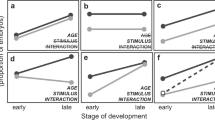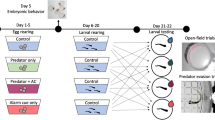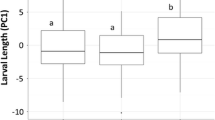Abstract
The arboreal embryos of red-eyed treefrogs (Agalychnis callidryas) hatch prematurely to escape from egg predators, and escape success increases with age. We assessed developmental changes in the behavior and hatching performance of embryos attacked by wasps (Polybia rejecta) and their contributions to improved embryo survival. We recorded videos of 4- and 5-day-old embryos exposed to wasp attacks and determined each embryo’s fate. For a stratified random sample of embryos that escaped and died, we determined the occurrence, sequence, and timing of events during wasp-embryo interactions. We constructed path diagrams of event sequences, tested for age effects on transition probabilities, and measured the durations of periods between key events. Overall, escape success was 38% higher in older embryos. They were more likely to hatch pre-emptively than younger ones, thus less likely to experience direct attacks, suggesting that developmental gains in mechanosensory sensitivity may increase hatching responses to indirect cues. During direct attacks, embryos were equally likely to be captured by wasps at both ages, and hatching speed was similar, suggesting no relevant difference in escape-hatching performance. After a wasp ruptured their egg capsule, older embryos were more likely to exit, and they did so much sooner; younger embryos remained in ruptured capsules for longer and were more likely to be attacked again. This developmental change in embryo behavior indicates decreased tolerance for egg-stage risk as the chance of tadpole survival increases, suggesting that ontogenetic adaptation to changing risk trade-offs contributes strongly to the developmental increase in escape success.
Significance statement
As animals develop, both their abilities and the optimal strategies for antipredator defense change, and some show ontogenetic adaptation of defensive behavior. This is documented in the larval and juvenile stages but rarely examined during the embryonic period, when development is fastest. We document substantial changes in embryo behavior across a 1-day period following the onset of predator-induced hatching in red-eyed treefrogs, with rapidly decreasing tolerance of egg-stage risk contributing to higher survival under wasp predation as the costs of hatching decrease. This provides evidence for ontogenetic adaptation of defensive behavior in a natural predation context and across an earlier developmental period than previously known, thereby strengthening results from prior work with vibration playbacks across later developmental stages. It suggests that even during periods of rapid development of morphology and abilities, understanding behavioral decisions may be crucial to explaining changes in survival.





Similar content being viewed by others
Data availability
The data collected for and analyzed in this paper are available on Dryad at 10.5061/dryad.63xsj3v6h.
References
Akre KL, Ryan MJ (2010) Complexity increases working memory for mating signals. Curr Biol 20:502–505. https://doi.org/10.1016/j.cub.2010.01.021
Atherton JA, McCormick MI (2015) Active in the sac: damselfish embryos use innate recognition of odours to learn predation risk before hatching. Anim Behav 103:1–6. https://doi.org/10.1016/j.anbehav.2015.01.033
Ball RE, Oliver MK, Gill AB (2016) Early life sensory ability-ventilatory responses of thornback ray embryos (Raja clavata) to predator-type electric fields. Dev Neurobiol 76:721–729. https://doi.org/10.1002/dneu.22355
Bate M (1999) Development of motor behaviour. Curr Opin Neurobiol 9:670–675. https://doi.org/10.1016/S0959-4388(99)00031-8
Bosque C, Bosque MT (1995) Nest predation as a selective factor in the evolution of developmental rates in altricial birds. Am Nat 145:234–260. https://doi.org/10.1086/285738
Caldwell MS, McDaniel JG, Warkentin KM (2009) Frequency information in the vibration-cued escape hatching of red-eyed treefrogs. J Exp Biol 212:566–575. https://doi.org/10.1242/jeb.026518
Caro TM (2005) Antipredator defenses in birds and mammals. University of Chicago Press, Chicago
Cassill DL, Vo K, Becker B (2008) Young fire ant workers feign death and survive aggressive neighbors. Naturwissenschaften 95:617–624. https://doi.org/10.1007/s00114-008-0362-3
Chalcraft DR, Andrews RM (1999) Predation on lizard eggs by ants: species interactions in a variable physical environment. Oecologia 119:285–292. https://doi.org/10.1007/s004420050788
Cohen KL, Seid MA, Warkentin KM (2016) How embryos escape from danger: the mechanism of rapid, plastic hatching in red-eyed treefrogs. J Exp Biol 219:1875–1883. https://doi.org/10.1242/jeb.139519
Cohen KL, Piacentino ML, Warkentin KM (2019) Two types of hatching gland cells facilitate escape-hatching at different developmental stages in red-eyed treefrogs, Agalychnis callidryas (Anura: Phyllomedusidae). Biol J Linn Soc 126:751–767. https://doi.org/10.1093/biolinnean/bly214
Crowder C, Ward J (2022) Embryonic antipredator defenses and behavioral carryover effects in the fathead minnow (Pimephales promelas). Behav Ecol Sociobiol 76:27. https://doi.org/10.1007/s00265-022-03136-2
Dall SRX, Giraldeau LA, Olsson O, McNamara JM, Stephens DW (2005) Information and its use by animals in evolutionary ecology. Trends Ecol Evol 20:187–193. https://doi.org/10.1016/j.tree.2005.01.010
Doody JS (2011) Environmentally cued hatching in reptiles. Integr Comp Biol 51:49–61. https://doi.org/10.1093/icb/icr043
Drewes RC, Altig R (1996) Anuran egg predation and heterocannibalism in a breeding community of East African frogs. Trop Zool 9:333–347. https://doi.org/10.1080/03946975.1996.10539316
Du WG, Shine R (2022) The behavioural and physiological ecology of embryos: responding to the challenges of life inside an egg. Biol Rev 97:1272–1286. https://doi.org/10.1111/brv.12841
Edmunds M (1974) Defence in animals: a survey of anti-predator defences. Longman, Burnt Mill, UK
Fuiman LA, Magurran AE (1994) Development of predator defences in fishes. Rev Fish Biol Fisher 4:145–183. https://doi.org/10.1007/BF00044127
Gervais CR, Nay T, Brown C (2021) Friend or foe? Development of odour detection, differentiation and antipredator response in an embryonic elasmobranch. Mar Freshw Res 72:942–949. https://doi.org/10.1071/MF20108
Gomez-Mestre I, Warkentin KM (2007) To hatch and hatch not: similar selective trade-offs but different responses to egg predators in two closely related, syntopic treefrogs. Oecologia 153:197–206. https://doi.org/10.1007/s00442-007-0708-0
Gomez-Mestre I, Wiens JJ, Warkentin KM (2008) Evolution of adaptive plasticity: risk-sensitive hatching in Neotropical leaf-breeding treefrogs. Ecol Monogr 78:205–224. https://doi.org/10.1890/07-0529.1
Güell BA, Jung J, Almanzar A, Cuccaro-Díaz J, Warkentin KM (2022) Ontogeny of risk assessment and escape-hatching performance by red-eyed treefrog embryos in two threat contexts. J Exp Biol 225:jeb244533. https://doi.org/10.1242/jeb.244533
Guevara-Molina EC, Gomes FR, Warkentin KM (2022) Heat-induced hatching of red-eyed treefrog embryos: hydration and clutch structure increase behavioral thermal tolerance. Integr Org Biol 4:obac041. https://doi.org/10.1093/iob/obac041
Hall WG, Oppenheim RW (1987) Developmental psychobiology: prenatal, perinatal, and early postnatal aspects of behavioral development. Annu Rev Psychol 38:91–128. https://doi.org/10.1146/annurev.ps.38.020187.000515
Helfman GS (1989) Threat-sensitive predator avoidance in damselfish-trumpetfish interactions. Behav Ecol Sociobiol 24:47–58. https://doi.org/10.1007/BF00300117
Helfman GS, Winkelman DL (1997) Threat sensitivity in bicolor damselfish: effects of sociality and body size. Ethology 103:369–383. https://doi.org/10.1111/j.1439-0310.1997.tb00153.x
Hughey MC, Rogge JR, Thomas K, McCoy MW, Warkentin KM (2015) Escape-hatching responses of individual treefrog embryos vary with threat level in wasp attacks: a mechanistic analysis. Behaviour 152:1543–1568. https://doi.org/10.1163/1568539X-00003291
Jung J, McDaniel JG, Warkentin KM (2017) Ontogeny of vibration-cued escape hatching in red-eyed treefrogs: two reasons older embryos hatch more. Integr Comp Biol 57:e82
Jung J, Kim SJ, Pérez Arias SM, McDaniel JG, Warkentin KM (2019) How do red-eyed treefrog embryos sense motion in predator attacks? Assessing the role of vestibular mechanoreception. J Exp Biol 222:jeb206052. https://doi.org/10.1242/jeb.206052
Jung J, Serrano-Rojas SJ, Warkentin KM (2020) Multimodal mechanosensing enables treefrog embryos to escape egg-predators. J Exp Biol 223:jeb236141. https://doi.org/10.1242/jeb.236141
Jung J, McDaniel JG, Warkentin KM (2021) Escape-hatching decisions show adaptive ontogenetic changes in how embryos manage ambiguity in predation risk cues. Behav Ecol Sociobiol 75:141. https://doi.org/10.1007/s00265-021-03070-9
Jung J, Guo M, Crovella ME, McDaniel JG, Warkentin KM (2022) Frog embryos use multiple levels of temporal pattern in risk assessment for vibration-cued escape hatching. Anim Cogn 25:1527–1544. https://doi.org/10.1007/s10071-022-01634-4
Koops MA (2004) Reliability and the value of information. Anim Behav 67:103–111. https://doi.org/10.1016/j.anbehav.2003.02.008
Lima SL, Dill LM (1990) Behavioral decisions made under the risk of predation: a review and prospectus. Can J Zool 68:619–640. https://doi.org/10.1139/z90-092
Mezrai N, Arduini L, Dickel L, Chiao C-C, Darmaillacq A-S (2020) Awareness of danger inside the egg: evidence of innate and learned predator recognition in cuttlefish embryos. Learn Behav 48:401–410. https://doi.org/10.3758/s13420-020-00424-7
Miranda LE, Hubbard WD (1994) Winter survival of age-0 largemouth bass relative to size, predators, and shelter. N Am J Fish Manag 14:790–796. https://doi.org/10.1577/1548-8675(1994)0142.3.CO;2
Orians GH, Janzen DH (1974) Why are embryos so tasty? Am Nat 108:581–592. https://doi.org/10.1086/282937
Oulton LJ, Haviland V, Brown C (2013) Predator recognition in rainbowfish, Melanotaenia duboulayi, embryos. PLoS One 8:e76061. https://doi.org/10.1371/journal.pone.0076061
Raveret Richter M (2000) Social wasp (Hymenoptera: Vespidae) foraging behavior. Annu Rev Entomol 45:121–150. https://doi.org/10.1146/annurev.ento.45.1.121
Raveret Richter M, Jeanne RL (1985) Predatory behavior of Polybia sericea (Oliver), a tropical social wasp (Hymenoptera: Vespidae). Behav Ecol Sociobiol 16:175–170. https://doi.org/10.1007/BF00295151
Raveret Richter M, Jeanne RL (1991) Hunting behaviour, prey capture and ant avoidance in the tropical social wasp Polybia sericea (Hymenoptera: Vespidae). Insect Soc 38:139–147. https://doi.org/10.1007/BF01240964
Romagny S, Darmaillacq A-S, Guibe M, Bellanger C, Dickel L (2012) Feel, smell and see in an egg: emergence of perception and learning in an immature invertebrate, the cuttlefish embryo. J Exp Biol 215:4125–4130. https://doi.org/10.1242/jeb.078295
Rydén O (1978) Differential responsiveness of great tit nestlings, Parus major, to natural auditory stimuli: response-strength as related to stimulus significance and previous individual exposure. Z Tierpsychol 47:236–253. https://doi.org/10.1111/j.1439-0310.1978.tb01834.x
Rydén OO (1982) Selective resistance to approach: a precursor to fear responses to an alarm call in great tit nestlings Parus major. Dev Psychobiol 15:113–120. https://doi.org/10.1002/dev.420150204
Salazar-Nicholls MJ, Escobar KD, Warkentin KM (2017) Development of hatching ability in red-eyed treefrogs: escape from complications. Integr Comp Biol 57:e141
Salazar-Nicholls MJ, Macias H, Warkentin KM (2020) Ontogeny and extent of hatching enzyme accumulation in red-eyed treefrog embryos. Integr Comp Biol 60:e410
Salica MJ, Vonesh JR, Warkentin KM (2017) Egg clutch dehydration induces early hatching in red-eyed treefrogs Agalychnis callidryas. PeerJ 5:e3549. https://doi.org/10.7717/peerj.3549
Stiller RB, McBrayer LD (2013) The ontogeny of escape behavior, locomotor performance, and the hind limb in Sceloporus woodi. Zoology 116:175–181. https://doi.org/10.1016/j.zool.2013.02.001
Sullivan KA (1989) Predation and starvation: age-specific mortality in juvenile juncos (Junco phaenotus). J Anim Ecol 58:275. https://doi.org/10.2307/5000
Tejedo M (1991) Effect of predation by two species of sympatric tadpoles on embryo survival in natterjack toads (Bufo calamita). Herpetologica 47:322–327
Touchon JC, McCoy MW, Vonesh JR, Warkentin KM (2013) Effects of plastic hatching timing carry over through metamorphosis in red-eyed treefrogs. Ecology 94:850–860. https://doi.org/10.1890/12-0194.1
Trimmer PC, Houston AI, Marshall JAR, Mendl MT, Paul ES, McNamara JM (2011) Decision-making under uncertainty: biases and Bayesians. Anim Cogn 14:465–476. https://doi.org/10.1007/s10071-011-0387-4
Üveges B, Fera G, Móricz ÁM, Krüzselyi D, Bókony V, Hettyey A (2017) Age- and environment-dependent changes in chemical defences of larval and post-metamorphic toads. BMC Evol Biol 17:137. https://doi.org/10.1186/s12862-017-0956-5
Vonesh J, Ross S (2000) Dipteran predation on the arboreal eggs of four Hyperolius frog species in western Uganda. Copeia 2000:560–566. https://doi.org/10.1643/0045-8511(2000)000[0560:DPOTAE]2.0.CO;2
Warkentin KM (1995) Adaptive plasticity in hatching age: a response to predation risk trade-offs. P Natl Acad Sci USA 92:3507–3510. https://doi.org/10.1073/pnas.92.8.3507
Warkentin KM (1999) The development of behavioral defenses: a mechanistic analysis of vulnerability in red-eyed tree frog hatchlings. Behav Ecol 10:251–262. https://doi.org/10.1093/beheco/10.3.251
Warkentin KM (1999) Effects of hatching age on development and hatchling morphology in the red-eyed treefrog, Agalychnis callidryas. Biol J Linn Soc 68:443–470. https://doi.org/10.1006/bijl.1999.0325
Warkentin KM (2000) Wasp predation and wasp-induced hatching of red-eyed treefrog eggs. Anim Behav 60:503–510. https://doi.org/10.1006/anbe.2000.1508
Warkentin KM (2002) Hatching timing, oxygen availability, and external gill regression in the tree frog, Agalychnis callidryas. Physiol Biochem Zool 75:155–164. https://doi.org/10.1086/339214
Warkentin KM (2005) How do embryos assess risk? Vibrational cues in predator-induced hatching of red-eyed treefrogs. Anim Behav 70:59–71. https://doi.org/10.1016/j.anbehav.2004.09.019
Warkentin KM (2006) Temporal pattern cues in vibrational risk assessment by embryos of the red-eyed treefrog, Agalychnis callidryas. J Exp Biol 209:1376–1384. https://doi.org/10.1242/jeb.02150
Warkentin KM (2011a) Plasticity of hatching in amphibians: evolution, trade-offs, cues and mechanisms. Integr Comp Biol 51:111–127. https://doi.org/10.1093/icb/icr046
Warkentin KM (2011b) Environmentally cued hatching across taxa: embryos respond to risk and opportunity. Integr Comp Biol 51:14–25. https://doi.org/10.1093/icb/icr017
Warkentin KM, Caldwell MS (2009) Assessing risk: Embryos, information, and escape hatching. In: Dukas R, Ratcliffe JM (eds) Cognitive Ecology II. University of Chicago Press, Chicago, pp 177–200
Warkentin KM, Currie CR, Rehner SA (2001) Egg-killing fungus induces early hatching of red-eyed treefrog eggs. Ecology 82:2860–2869. https://doi.org/10.1890/0012-9658(2001)082[2860:EKFIEH]2.0.CO;2
Warkentin KM, Buckley CR, Metcalf KA (2006) Development of red-eyed treefrog eggs affects efficiency and choices of egg-foraging wasps. Anim Behav 71:417–425. https://doi.org/10.1016/j.anbehav.2005.06.007
Warkentin KM, Caldwell MS, Siok TD, D’Amato AT, McDaniel JG (2007) Flexible information sampling in vibrational assessment of predation risk by red-eyed treefrog embryos. J Exp Biol 210:614–619. https://doi.org/10.1242/jeb.001362
Warkentin KM, Cuccaro Diaz J, Güell BA, Jung J, Kim SJ, Cohen KL (2017) Developmental onset of escape-hatching responses in red-eyed treefrogs depends on cue type. Anim Behav 129:103–112. https://doi.org/10.1016/j.anbehav.2017.05.008
Warkentin KM, Jung J, Rueda Solano LA, McDaniel JG (2019) Ontogeny of escape-hatching decisions: vibrational cue use changes as predicted from costs of sampling and false alarms. Behav Ecol Sociobiol 73:51. https://doi.org/10.1007/s00265-019-2663-2
Warkentin KM, Jung J, McDaniel JG (2022) Research approaches in mechanosensory-cued hatching. In: Hill PSM, Mazzoni V, StritihPeljhan N, Virant-Doberlet M, Wessel A (eds) Biotremology: physiology, ecology, and evolution. Springer, Cham, Switzerland, pp 157–201
Warkentin KM (2017) Development of red-eyed treefrog embryos: a staging table for integrative research on environmentally cued hatching. Integr Comp Biol 57:e175. https://doi.org/10.6084/m9.figshare.10070558.v1
Whittington ID, Kearn GC (2011) Hatching strategies in monogenean (platyhelminth) parasites that facilitate host infection. Integr Comp Biol 51:91–99. https://doi.org/10.1093/icb/icr003
Wiedenmayer CP (2009) Plasticity of defensive behavior and fear in early development. Neurosci Biobehav R 33:432–441. https://doi.org/10.1016/j.neubiorev.2008.11.004
Willink B, Palmer MS, Landberg T, Vonesh JR, Warkentin KM (2014) Environmental context shapes immediate and cumulative costs of risk-induced early hatching. Evol Ecol 1:103–116. https://doi.org/10.1007/s10682-013-9661-z
York CA, Bartol IK (2016) Anti-predator behavior of squid throughout ontogeny. J Exp Mar Biol Ecol 480:26–35. https://doi.org/10.1016/j.jembe.2016.03.011
Acknowledgements
We thank Julie Jung, María José Salazar Nicholls, Karina Escobar, and Crystal Tippett for their assistance with egg collection and care in the field. We thank members of the Gamboa Frog Group at STRI and the Egg Science Research Group at Boston University for discussions of this work at multiple stages and for feedback on an earlier version of the manuscript. We thank two anonymous reviewers for feedback that improved the manuscript.
Funding
This research was funded by the National Science Foundation (IOS-1354072 to KMW), Boston University, and the Smithsonian Tropical Research Institute. AC and EKG were funded by Boston University’s Undergraduate Research Opportunities Program.
Author information
Authors and Affiliations
Contributions
KMW and AC designed the experiment. AC conducted the experiment. AC and EKG analyzed the videos. EKG and BAG analyzed the data. EKG drafted the manuscript. KW and BG edited the manuscript. All authors reviewed the final manuscript. KMW obtained project funding and supervised the work.
Corresponding author
Ethics declarations
Ethics approval
All applicable international, national, and institutional guidelines for the use of animals were followed. This research was conducted with IACUC approval from the Smithsonian Tropical Research Institute (2014–0601-2017-A5) and Boston University (14–008) under research permit No. SE/A-59–16 from the Panamanian Ministerio de Ambiente.
Conflict of interest
The authors declare no competing interests.
Additional information
Communicated by A. Taylor Baugh
Publisher's note
Springer Nature remains neutral with regard to jurisdictional claims in published maps and institutional affiliations.
Rights and permissions
Springer Nature or its licensor (e.g. a society or other partner) holds exclusive rights to this article under a publishing agreement with the author(s) or other rightsholder(s); author self-archiving of the accepted manuscript version of this article is solely governed by the terms of such publishing agreement and applicable law.
About this article
Cite this article
Gomez, E.K., Chaiyasarikul, A., Güell, B.A. et al. Developmental changes in red-eyed treefrog embryo behavior increase escape-hatching success in wasp attacks. Behav Ecol Sociobiol 77, 52 (2023). https://doi.org/10.1007/s00265-023-03324-8
Received:
Revised:
Accepted:
Published:
DOI: https://doi.org/10.1007/s00265-023-03324-8




